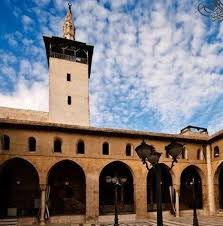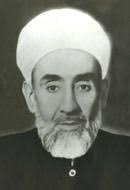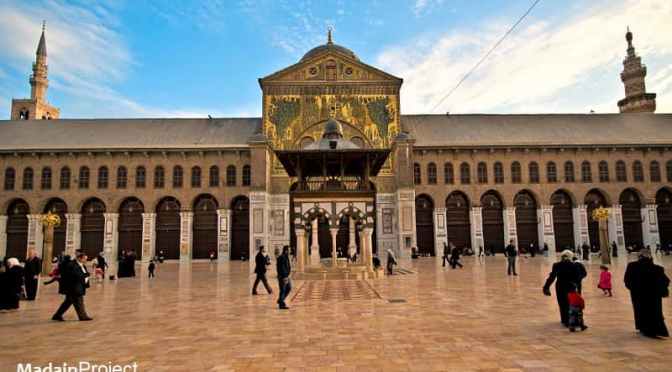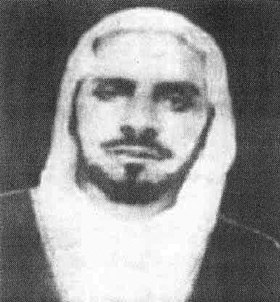Category Archives: Biographies
18 RAMADAN 1444: REMEMBERING A TRUE FAQIH

So let us take this moment to remember the Shaikh, Abu Maajid Salaah Badran. He was the khatib and imam of Al-Jami` ul-Kabir in Duma. He was born in the year 1381 in the city of Duma and learned from his father, the Faqih and Senior Scholar, the Shaikh, `Umar ibn Isma`il Badran.[1] He taught regularly and focused the people of his region on knowledge and implementation of it along with good deeds. After that, he would marry, his wife then giving birth to two sons, Maajid and Bara’.
The Shaikh would breathe his last at 60 years of age, having contracted c(ovid) nineteen and being one of the first (in Sham) to die from complications involving it[2] on 26 Dhul Hijjah 1441 before Salat ul-`Asr while in the Ibn An-Nafees Hospital in Damascus. We ask that Allah show him mercy, that his family be given patience and good resolve, especially given the fact that his two sons died in a faraway land.[3]
[1] 1345-1403 (AD1926-1984). He is `Umar ibn Isma`il ibn Badran Ad-Dumi. One of the fiqh scholars of the Hanbalis, he was Imam and Khatib of As-Sammaanah Neighbourhood Central Masjid. He was good friend to many hadith scholars that he met while in Damascus. Ad-Dumi is the paternal cousin of the senior scholar and Faqih, the Shaikh, `Abdul Qadir Badran (d.1346 (AD1927). One of his teachers was his maternal uncle, the declared mufti of Duma, the Shaikh, `Uthman Al-Khatib. He is the author of two small texts for easy research, the most well known being Research for the Traveler in Discharging the Rites of the Hajj and `Umrah (Ar.Mabhath ul-Maslak fi Ma’rifat il-Mansak fi Manasik il-Hajj wal-‘Umrah). He would breathe his last at 58 years of age.
[2] And it is very sad indeed that some Slaves of Allah denied the reality of the influenza outbreak due to conspiracy theories, much the same way that some Slaves of Allah denied the chemical attack on Duma, although we have pictures of Imam Isma`il ibn Badran and others recovering at home from the attacks. There is no might or power except in Allah.
[3] Taken from a family post online the day of his death.
11 RAMADAN 1444: THE LIFE AND TIMES OF AHMAD IBN HANBAL – FIRST SESSION
8 RAMADAN 1444: THE GRAVES OF THE PROPHETS

من سنن الأنبياء البحث عن قبور الأنبياء وإكرامها:
From the Sunan of the Prophets is researching about the graves of the prophets and honouring them
أخرج الحاكم بإسناد صحيح عن أبي موسى الأشعري عن النبي صلى الله عليه وسلم -في قصة طويلة مع أعرابي فيها – أنه قال صلى الله عليه وسلم : عجز هذا أن يكون كعجوز بني إسرائيل.فقال له أصحابه : ما عجوز بني إسرائيل يا رسول الله
Imam Al-Hakim[1] has collected a hadith with a sahih chain from the narrative of Abu Musa Al-Ash`ari, may Allah be pleased with him, from the Prophet, peace and blessings of Allah be upon him, in a long narrative he had with a Bedouin in which the Prophet, peace and blessings of Allah be upon him, said, “This old woman is like the old woman from the Children of Israel”. His Companions said to him, “Messenger of Allah, what is the old woman from the Children of Israel?”
فقال: إن موسى حين أراد أن يسير ببني إسرائيل ضل عنه الطريق فقال لبني إسرائيل: ما هذا؟ قال فقال له علماء بني إسرائيل: إن يوسف عليه السلام حين حضره الموت أخذ علينا موثقا من الله أن لا نخرج من مصر حتى تنقل عظامه معنا فقال موسى: أيكم يدري أين قبر يوسف ؟
He replied, “Indeed the Prophet Musa, peace be upon him, when he went to travel with the Children of Israel and they became lost, he said to them, ‘What is this place we are at?’ The scholars of the Children of Israel said, ‘Indeed [the Prophet] Yusuf, peace be upon him, when death came to him, he took a solemn covenant from us in the Name of Allah that we would not exit from the land of Egypt unless we exhumed his remains and took them with us’. So [the Prophet] Musa, peace be upon him, said, ‘So how do you know about the location of the grave of [the Prophet] Yusuf?’.”
فقال علماء بني إسرائيل ما يعلم أحد مكان قبره إلا عجوز لبني إسرائيل .فأرسل إليها موسى فقال: دلينا على قبر يوسف قالت: لا
والله حتى تعطيني حكمي فقال لها: ما حكمك؟ قالت : حكمي أن أكون معك في الجنة . فكأنه كره ذلك
“The scholars from the Children of Israel said, ‘No one knows the location of his grave except the old woman from the Children of Israel’. So [the Prophet] Musa, peace be upon him, sent word to her about it and said, ‘Show us where the grave of [the Prophet] Yusuf is located’. She said, ‘By Allah, I shall not do so until you give me my ruling on the matter’. He said to her, ‘So what is your ruling?’ She said, ‘My ruling is that you declare me among those to be with you in the Paradise’.[2] And [the Prophet] Musa looked as if he disliked that”.[3]
قال: فقيل له: أعطها حكمها فأعطاها حكمها- في رواية ابن حبان فأوحى الله إليه أن أعطها حكمها – فانطلقت بهم إلى بحيرة مستنقعة ماء فقالت : لهم انضبوا هذا الماء فلما أنضبوا قالت : لهم احفروا فحفروا فاستخرجوا عظام يوسف فلما أن أقلوه من الأرض إذ الطريق مثل ضوء النهار
“So it was said to him, ‘Go ahead and let her have her ruling’. So he gave her the ruling”. And in the narrative of Ibn Hibban[4] it is mentioned: “Allah revealed to him that He gave the ruling she had requested. So she set out with them to a river with swamplike water. She said, ‘They will have to drain this water’. So when they separated it and drained it, she said, ‘They will have to dig and excavate the grave’. So they dug and excavated and then extracted the remains of [the Prophet] Yusuf. Once they lifted him from the grave, they took the remains and it lit the way and guided them to the path like a beam of light one would see in the daytime”.
قال الحاكم: هذا حديث صحيح على شرط الشيخين ولم يخرجاه، ووافقه الذهبي، ورواه ابن حبان، والطبري عن مجاهد موقوفا.. وصححه الألباني
Al-Hakim said, “This is a sahih hadith according to the conditions of the two Shaikhs[5] although they did not narrate it in their collections”. And Imam Adh-Dhahabi[6] agreed with the grading. And it was also collected by Imams Ibn Hibban and At-Tabari from Mujahid from a mawquf[7] chain. And even Al-Albani[8] declared it sahih.
فوائد القصة:
Some of the benefits of the narrative above are:
إكرام قبور الأنبياء وأجسادهم
Firstly, honouring the graves of the prophets [peace be upon them] and their bodies;
إن قبور الأنبياء قد يعرفها العلماء وكبار السن بالرواية ويكفي فيها خبر آحاد ولا يشترط فيها الوحي
Secondly, the graves of the prophets are known by the scholars and elderly women by sound narrative and even a singly narrated report is sufficient to establish while revelation is not required to know it.
إن في إكرام قبور الأنبياء بركة ورحمة وهداية
Thirdly, when one honours the graves of the prophets, it is a source of barakah, rahmah and hidayah.[9]
كتبه الشيخ مصطفى حمدو عليان
As mentioned by the Shaikh, Mustafa Hamdu `Ulayyan.
[1] 321-405 (AD930-1014). He is Abu `Abdillah Muhammad ibn `Abdullah ibn Muhammad ibn Hamdawaih ibn Na`im ibn Al-Hakim An-Naisaburi Ash-Shafi`ii At-Tahmani. Known commonly as Al-Hakim, he was called the Shaikh of the Muhaddithin, the Imam, the senior scholar, the memoriser and the trustworthy narrator. He authored his work Al-Mustadrak near the end of his life just after the death of Ad-Daraqutni. cf.Adh-Dhahabi in Siyar, vol.17, pp.163-177
[2] This means not just her being in Paradise, which is established for the believer, but she is asking that she be one of his utmost companions in the Paradise.
[3] This is on account of the fact (1) prophets do not like to make guaranteed promises and then be refused by Allah, (2) prophets have a higher sense of humility and do not put themselves to a higher standard among their people.
[4] 275-354 (AD884-965). He is Abu Hatim Muhammad ibn Hibban ibn Ahmad ibn Hibban ibn Mu`adh ibn Ma`bad At-Tamimi Ad-Darimi Al-Busti. The Imam, the senior scholar, the memoriser, the Shaikh of Khurasan, he left behind texts such as his As-Sahih that covered hadith and its more detailed sciences. He died in Bust, a city in Afghanistan and was laid to rest. cf.Adh-Dhahabi in Siyar, vol.16, pp.93-104
[5] This refers to Imams Al-Bukhari and Muslim.
[6] d.748 (AD1347). He is Shams ud-Din Muhammad ibn Ahmad ibn `Uthman Adh-Dhahabi. Senior verifier of hadith narration and narrators, he is one of the foremost references in the science of analysis, checking, grading of Ahadith. Please see Siyar A`lam un-Nubala’, vol.1, pp.5-73.
[7] Ar.marfu` Imam Shams ud-Din Ibn `Abdul Hadi (d.744 (AD1377) said of the affair: “It is said to be a statement exclusively attributed to the Messenger of Allah, peace and blessings of Allah be upon him either by being muttasil or munqati`.Muttasil designates a type of hadith in which its chain of transmission has everyone in it narrating from the narrators he heard from above him all the way until the end. This happens for the most part with marfu` and mawquf examples of this category. Munqati` is a hadith in which its chain of narration is not contiguous as one, two, three or more people have been dropped from the chain. And Allah knows best about these narrations”. cf.My Ardent Desire for Hadith, pp.18-20
[8] Even Salafis who might distort revelation and other affairs, it is at times the case that even they cannot resist the truth that our Lord has revealed.
[9] As they are infallible and divinely set aside, so honouring them is showing honour and respect to Allah, Glorified and Exalted is His Name.
7 RAMADAN 1444: THE LIFE AND TIMES OF AHMAD IBN HANBAL – INTRODUCTORY REMARKS
In this Ramadan, we earnestly endeavour to complete a concise biography of the Imam, Ahmad ibn Hanbal (d.241 (AD855). Please join us and follow along our journey through the life of one of the most important figures of the First Three Generations.
HOW A MARJA` INSPIRED RAILWAY WORKS, LAND EXPLORATION AND SURVEYING
سبب الخط الحديدي الحجازي :
The cause for the establishment of the Hijaz Railway
الشيخ المهندس العلامة محمد بن حسن الشطي – من شيوخ الحنابلة ت ١٨٩٨م = ١٣٠٧هج- وهو جد شيخنا محمد عصام رحمه الله وكان قد عرض علي تحقيق بعض رسائله المخطوطة :
The Shaikh, the Engineer, the Senior Scholar, Muhammad ibn Hasan Ash-Shatti (d.1307 (AD1898) – from the Shaikhs of the Hanbalis – who is also the grandfather of our Shaikh, Muhammad `Isam Ash-Shatti, may Allah have mercy upon him, and he handed over to me some of the manuscripts of his grandfather and remarked:
“وكانت له آراء إصلاحية في أمور شتى يعرضها على الحكومة فتقدرها وتعمل بها ومنها مد خط حديدي من دمشق الى مكة، وله رسائل في المساحة والفلك وكان مرجع أهل دمشق في المناسخات والمساحات وتقسيم المياه والأراضي”.مختصر طبقات الحنابلة 199.
“He had opinions and ideas about rectification on many affairs. He even brought across to the government principles that they were able to do and they acted by them. One such rectification and reform was him telling them to build a railway extending from Damascus to Makkah, thus embracing Al-Hijaz. And he [the Shaikh, Muhammad ibn Hasan Ash-Shatti] has many research texts covering land surveying, astronomy and was also the Authority of the people of Damascus in transportation, land surveying and also water works and land exploration”.[1]
د.مصطفى عليان
As mentioned by the Shaikh, Mustafa Hamdu `Ulayyan.
[1] Mukhtasar Tabaqat il-Hanabilah, pp.198-199
A VISIT TO SHAM AND THE GATHERING OF THE SCHOLARS
لما قدم دمشق العلامة الشيخ عبد الحي الكتاني دعاه العلامة الشيخ محمود بن محمد السيد الحنبلي إلى مدينة دوما وأقام له حفلة ، حضرها كثير من علماء دمشق منهم السيد محمد المكي الكتاني والشيخ عبد الجليل الدرة . وأنشد الشيخ محمود بهذه المناسبة يقول :
When the senior scholar, the Shaikh, `Abdul Hayy Al-Kattani,[1] arrived in Damascus, he was called by the senior scholar, the Shaikh, Mahmud ibn Muhammad As-Sayyid Al-Hanbali[2] to the city of Duma and take residence there for an event. Many of the scholars from Damascus attended there, including As-Sayyid Muhammad Al-Makki Al-Kattani[3] and the Shaikh, `Abdul Jalil Ad-Durrah. The Shaikh, Mahmud As-Sayyid, recited the following poetry for the event in which he said:
الله أكبر زارنا الكتاني ** بحر العلوم ومعدن العرفان
Allah is the Greatest! Al-Kattani paid a visit to us,
An ocean of the sciences, a pillar of direct knowledge of Allah that one can trust!
هو سيد من سيد من سيد ** للهاشمي المصطفى العدناني
He is a master, son of a master from the line of a master indeed,
The Hashimi, Al-Mustafa, Al-`Adnani of the blessed line in word and deed!
يروي الحديث مسلسلاً ومعنعناً ** بصحيح إسناد ونطق لسان
He narrates the hadith with successive people, one from one and no interruption,
Sahih transmission from his mouth to ours through clear dictation!
رحمهم الله ورضي عنهم
And may Allah have mercy upon them and be pleased with them!
كتبه الشيخ مصطفى حمدو عليان
As written by the Shaikh, Mustafa Hamdu `Ulayyan
[1] 1300-1382 (AD1884-1962). He is Abu `Abdil Ahad `Abdul Hayy ibn `Abdul Kabir ibn Muhammad ibn `Abdul Wahid Al-Kattani Al-Idrisi Al-Hasani Al-Fasi. One of the giants of Maliki fiqh and Hadith sciences of his time, this direct descendant of the Prophet Muhammad, peace and blessings of Allah be upon him, through his son Al-Hasan, peace be upon him, was one of the 500 students that had sat with Imam Al-Qaddumi in his time. Coming from such a large and august family, he started his knowledge journey with his father and mother, brother, maternal cousin, maternal uncle. This towering Imam is the writer of some 500 books, one of which is Fahris ul-Faharis in which he catalogues narrators, teachers and more. Among the senior and last students of Imam Al-Qaddumi, he accompanied him on the Hajj trip and is referenced as the “noble travel companion” or “noble companion” throughout the main body of his landmark text, Ar-Rihlah. cf.Al-Kattani’s Fahris ul-Faharis, vol.2, pp.939-941
[2] 1303-1369 (AD1885-1949). He is Mahmud ibn Muhammad As-Sayyid Al-Hanbali Ash-Shadhili Ad-Dumi. Born in the hamlet of Duma, he started by memorising the Qur’an with his first teacher, his father, the Shaikh, Muhammad As-Sayyid Ad-Dumi. He would also go on to learn from such great Imams as Mustafa ibn Ahmad Ash-Shatti, Muhammad Al-Hashimi, Muhammad Salih Al-Farfur, Abul-Khair Al-Maidani and many others. He left behind a large body of students that included his two sons, Hashim and `Abdullah and the great marja`, Imam Salih Ash-Shami. He was declared to be the leader of the saints by many in his time and upon his death he was buried in the main cemetery.
[3] 1312-1393 (AD1894-1973). He is Muhammad Makki ibn Muhammad ibn Ja`far ibn Idris Al-Kattani Al-Idrisi Al-Hasani. Major hadith scholar, Imam in fiqh, he was the son of the great Imam, Muhammad ibn Ja`far Al-Kattani. As a young man, he learned from local teachers and then in 1329 she emigrated to Al-Madinah the Radiant and he took from great scholars such as his father, his brother As-Sayyid Muhammad Az-Zamzami and many others. In addition to this, he took from some of the great scholars of Al-Azhar, Makkah in various sciences and came to become a high-ranking scholar in his early life.
BIOGRAPHY OF THE SENIOR SCHOLAR, `ABDULLAH AL-KHALAF AD-DAHAYYAN
He is the Shaikh, `Abdullah ibn Khalaf Ad-Dahayyan Al-Harbi Al-Hanbali
Birth and upbringing
Ad-Dahayyan (sometimes read as Ad-Dahyaan) was born in Al-Kuwait in on 28 Shawwal 1292, his father being an imam, khatib and Qur’an teacher in the city of Al-Majma`ah in Najd. The father moved from the Najd to Kuwait in the year 1285 after which time the marja` and his son was born.
Shaikh `Abdullah learned Qur’an with his father and also learned the beginnings of reading, writing and math[1] and this made learning something beloved to him. After reaching a certain point, his father sent him to learn fiqh from the Shaikh, Muhammad ibn `Abdullah Al-Faris, whom he accompanied and learned detailed matters of fiqh and Arabic.
Journey for `ilm
After this, in the year 1310, the Shaikh made his way to Az-Zubair[2] in Iraq to learn from the qualified scholars there, particular the Hanbali scholars. So while there he read to the following in fiqh:
The Shaikh, Salih ibn Hamad Al-Mabayyid
The Shaikh, `Abdullah ibn `Abdur-Rahman Al-Hamud
The Shaikh, Muhammad ibn `Abdullah Ala `Iwajan[3]
The Shaikh, `Abdullah Ad-Dahayyan was well known for his intelligence and quick take up of knowledge and he was loved by his shaikhs and teachers. They were surprised by his quickness and what they saw him do.
Ad-Dahayyan also showed great traits of truthfulness, sincerity, humility, good etiquettes, great morals and calm demeanour. After more than two years, the Shaikh, `Abdullah Khalaf Ad-Dahayyan returned to Al-Kuwait and received more authorisations in the Noble Qur’an, Hanbali fiqh, the six books of hadith and the books of Ahkam. The did this from some of the premier scholars of his time, which included:
The senior scholar of Najd, the Shaikh, Ibrahim ibn Salih ibn `Isa (d.1343)
The Shaikh, Muhammad ibn `Abdul Karim Ash-Shibl Al-Qassimi (d.1343)
In the year 1323, the Shaikh travelled to fulfill the obligation of Hajj and was able to go along with a caravan of many scholars, taking authorisations from them and also teaching others and giving authorisations. He spoke to them and they spoke to him. And it would be here while on Hajj that he would receive his marja`iyyah.
After he completed his Hajj, he travelled by sea to India, then to Musqat in Oman and then returned to Al-Kuwait and with the knowledge he had gained begun to put himself to the service of his people.
Being a humble man, he often conferred with different scholars to discuss matters and these are preserved in books. Those who corresponded with include:
The Shaikh, the senior scholar, Ibrahim ibn Salih ibn `Isa
The Shaikh, the senior scholar, `Abdul Qadir ibn Badran (d.1346)
The Shaikh, Muhammad Al-Amin Ash-Shanqiti
The Shaikh, Mahmud Shukri Al-Alusi
The Shaikh, Muhammad ibn `Abdul `Aziz ibn Mani` and others, may Allah be pleased with all of them.
The Shaikh, `Abdullah ibn Khalaf Ad-Dahayyan then had turned over to him the post of imam and khatib at the Central Masjid established by Nasir ibn Yusuf Al-Badr. Many people came from all around the area, not just Al-Kuwait, in order to hear the Shaikh’s khutbahs and lessons.
He had to be forced into a position (as he did not want it) to act as sentencing qadi which he reluctantly accepted after the death of the Shaikh, `Abdullah ibn Khalid Al-`Adasani (d.1348). When he relented, he went forward to look after the people’s affairs and refused any wage or gifts given by people for the work that he did. He even refused admin fees for printing documents and the like.
His gatherings and students
Every morning the Shaikh, may Allah have mercy upon him, would read from Tafsir ul-Qur’an il-`Azim by Imam Ibn Kathir (d.774) and then he would read Imam Al-Bukhari’s Al-Jami` us-Sahih along with Imam Ibn Hajar’s (d.852) Fath ul-Bari.
In between the salahs of Maghrib and `Isha’, he would read in other sciences and branch fields of study. Whenever he completed a text, he would move on to the next one. He had a high level of insight into the books of Hanbali fiqh and taught regularly from the books of the latter-day Hanbali scholars.
Students of knowledge flocked to attend the gatherings of the Shaikh whenever he was there and many of the virtuous ones of Al-Kuwait were there. Some of the students of Ad-Dahayyan include:
The Shaikh, Yusuf ibn `Isa Al-Qana`ii
The Shaikh, `Abdul-`Aziz Ar-Rashid
The Shaikh, Yusuf Al-Hamud
The Shaikh, Ahmad Al-Khamis
The Shaikh, `Abdul Wahhab Al-`Abdullah Al-Faaris
The Shaikh, `Abdur-Rahman Ad-Dusari
The Shaikh, `Abdullah An-Nuri
The Shaikh, `Abdul Wahhab Al-`Abdur-Rahman Al-Faaris
The Shaikh, Muhammad ibn Sulaiman Al-Jarrah
The Shaikh, `Abdur-Rahman Al-`Ubaidan and others, may Allah be pleased with all of them.
His authored works
The works of the Shaikh do not fully demonstrate his knowledge as he was so busy looking after the people’s needs and affairs, he did not have time to put several books into print. In spite of this, he did leave behind a few works:
Al-Masa’il ul-Fiqhiyyah. This covers questions and answers from waters all the way to Hajj.
Diwan ul-Khutab il-Mimbariyyat il-`Asriyyah. This is a how to guide of giving khutbahs for people who are new.
Majalis Ramadan. This is a series of presentations on the virtues of Ramadan.
Mansak Saghir Fil-Hajj. A new Muslim’s guide to Hajj
Qasidah fi Rihlat il-Hajj. A poetic meter on Hajj and its virtues.
Risalah fi Du`a Khatam il-Qur’an. A selection of supplications for the one that has completed the Qur’an.
Al-Futuhat ur-Rabbaniyyah fil Majalis il-Wa`ziyyah. A series of admonitions to the Ummah about various topics, including neo-Platonist philosophy and the dangers of modernism, which he rightly linked to America.
And there were others besides this that were useful along with individual rulings he passed and these were hung up in the masjid or preserved in books.
The rank of the Shaikh
The library of the Shaikh was quite extensive and he had some valuable books, especially manuscripts which were sent forth or bequeathed to him from Sham, Egypt, Baghdad, Al-Hijaz and Najd until it reached a sizeable amount.
After the death of the Shaikh, the library was given as inheritance to his nephew, Shaikh Ahmad Al-Khamis and then after that this vast body of manuscripts passed to the Kuwaiti Ministry of Endowments.
After this, it was then handed over to the Fiqh Enyclopaedia Library of Kuwait for preservation and publishing where it is now housed.
The praise the scholars have for him
The historian, `Abdul `Aziz Ar-Rashid, said of him, “The Shaikh, `Abdullah is one of the most noble of the scholars of Al-Kuwait and the most pious. So whenever harsh or rough people came to his gathering, he was patient and magnanimous with these affairs and trials in addition to being humble and generous”.
The student of the Shaikh, `Abdullah Al-Nuri, may Allah have mercy upon him, said of him, “Those that knew the Shaikh, `Abdullah ibn Khalaf, they knew that he was a man of piety and humble for Allah in and of Himself. He was of great rank in the eyes of the people and spent his days benefiting the people, acting as a mufti for them, worshipping Allah, going among the people as an assistant, visiting the ill, wishing them condolences in their difficult times, he had great love in the hearts of the people and exalting the laws of the Religion. He was never known to have laziness and waywardness, and neither was it mentioned of him that he wasted an hour of his time in frivolity and aimlessness”.
The senior scholar of Sham, the Shaikh, `Abdul Qadir ibn Badran Al-Hanbali, may Allah have mercy upon him, said of the Shaikh, “The noble and virtuous senior scholar, the Shaikh of the Kuwaiti corridor and Najd, the Shaikh, `Abdullah Khalaf ibn Dahayyan, the scholar and virtuous teacher of those areas”.
The luminary of `Iraq, the Shaikh, Mahmud Shukri Al-Alusi said of the Shaikh, “He is noble scholar, the complete human being, the reminder of the First Three Generations when people saw him. He is the Shaikh, `Abdullah ibn Khalaf and Allah strengthened the Religion through him and made him a coolness of the eyes for the Muslims”.
His death
After spending a life filled with good and striving in which he served the people with knowledge, the Shaikh developed an illness that rendered him in a position in which he was bedridden until his death on 27 Ramadan 1349, having not gone past the age of 57 years. And may Allah have mercy upon the Shaikh with an enveloping mercy and be pleased with him and expand his goodness with all honour and generosity.[4]
[1] Notice that his parents taught him the beginning knowledge. It would be after that when the parents don’t know that they send him to someone else. In the English-speaking countries, so many know nothing and then send their children to learn and the children return home to desolate houses. This is light painting on the waves of the ocean with a paint brush.
[2] And it is a custom there that when someone has finished memorising the Zad and studying the commentary with comprehension, he then has a black `imamah wrapped around his head and he is commanded to teach.
[3] These three scholars were also the chief marja` people over the UAE and wrote a book of fiqh with countless fatawa on modern issues there as well as Iraq and the surrounding environs.
[4] Al-Masa’il ul-Fiqhiyyah, pp. 15-22










